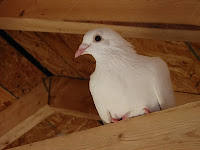Pigeon racing has been around as far back 220 A.D. However, the racing pigeon was specifically bred in Europe during the nineteenth century, and used to carry messages, especially in wartime. Examples come from the Franco-Prussian War in 1871; in 1914 during the First Battle of the Marne, the French army advanced 72 pigeon lofts with the troops; in the Second World War the UK used more than 250,000 homing pigeons, and of course the Dickin Medal was awarded to animals (and pigeons).
When we moved to Somerset (Southwest UK), he no longer raced them, but we still kept homing pigeons, and it was my job to take care of them.
I think this was possibly because he didn't want to climb the rickety ladder that led to the "pigeon loft" ie the attic space above the double garage. I remember that ladder even more than I remember the pigeons! as it was only a few pieces of mismatched wood nailed together haphazardly. I DEFINITELY remember the day it gave way, and as a 10-year-old I was left hanging by one arm from the trapdoor opening which led into the loft. Then the trapdoor banged shut on my arm. When you are ten, a six-foot drop onto concrete is a huge distance. When I dropped to the floor (eventually) I remember running down the driveway to our house, screaming all the way, and then my mother standing terrified in the doorway and asking me to *shake hands* (which I thought was really weird, until years later I realised she was checking that my fingers still worked and my arm was not broken).
But I loved the pigeons themselves fiercely. Chicks who didn't quite make it out of the egg were buried using an empty cigarette carton for a coffin and iced-lolly sticks for grave markers. I learned solemnity and reverence for all God's creatures in this way. And I learned to love a set of birds who probably only associated me with food and water. 'My' pigeon was a white one (named 'Whitey', with the stunning originality of a child). These birds were not pets, but they are a vivid memory.




No comments:
Post a Comment